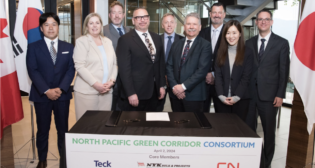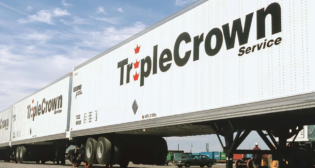
UP to STB: ‘Clearing Our Network Will Take Some Time’
Written by William C. Vantuono, Editor-in-ChiefUnion Pacific Chairman, President and CEO Lance Fritz on Aug. 5 responded to Surface Transportation Board Chairman Marty Oberman’s July 22 letter to Class I railroad CEOs requesting information on the extent of congestion at key U.S. container terminals and on their railroads’ policies and practices for assessing container demurrage fees. Oberman cited reports of “substantial charges being levied by the railroads for container storage at these terminals.” Following is UP’s full response:
Thank you for your July 22, 2021, letter. In that letter, you identify two concerns about the Class I freight rail network and the international intermodal supply chain: (1) significant container congestion, and (2) increased container storage fees at key U.S. terminals. I want to assure you that Union Pacific’s tireless efforts and continuous process improvements will yield improved fluidity within the network and clear congestion. But clearing our network will take some time, and it will require the cooperation of all stakeholders in the supply chain. Critical to clearing the congestion and keeping the network fluid will be vital non-railroad improvements to the inadequate takeaway capacity at our ramps that is the root cause of the congestion. We are working hard to help our customers understand the problem and improve their operations.
Though Union Pacific is an integral part of the international supply chain, we capture and execute a finite portion of the transportation pipeline. The intermodal transportation pipeline is driven by the decisions, actions, and capacity of all stakeholders in the pipeline, including steamship lines, shippers, receivers, ports, chassis owners, and drayage providers. All stakeholders must maintain a consistent flow of freight at every step of the process to avoid bottlenecks. Specifically, shippers and receivers are responsible for their decisions to overextend their capacity in shipping and receiving, which congests the supply chain. This overextension is beyond our control.
Union Pacific has performed efficiently in out-gating containers from our intermodal ramps. As demonstrated below, Union Pacific’s customer notification numbers have remained generally consistent. The customer notification numbers capture the average amount of time that it takes for a customer to retrieve their container after they have been notified it is available for pickup:
With our continuous process flow evaluation, we readily identified two outliers in our Joliet (Global 4) and Los Angeles (ICTF JP0I 7) terminals. We discovered the uptick in the container congestion directly correlated to the lack of available space in the customers’ warehouses and our customers’ workforce challenges.( To further illustrate container congestion at Global 4, please see Appendix A.) The drayage and warehouse operations in major markets have been slow due to outbound drayage processing. Union Pacific recognizes the current difficulty for dray carriers to manage efficiently the outbound movement of containers once they are in a stacked location. To ease the stress on our ocean carrier partners, Union Pacific implemented a policy to cap fees at $2,450 in Global 4 when the container is in-stack. Additionally, we have temporarily opened our Global 4 intermodal facility, near Chicago, to private chassis to allow more options for shippers to out-gate their containers. Lastly, Union Pacific has re-opened its Global 3 facility, also near Chicago, to reduce congestion at Global 4 and facilitate container retrieval. Union Pacific is committed to working with our customers to improve supply chain flow.
Union Pacific agrees that an efficient rail system free from excessive congestion is vital to all supply chain stakeholders. We understand our operations must be synchronized with our supply chain partners by reconciling our performance objectives with resource usage. To that end, Union Pacific proactively engaged ocean carriers by holding a broad-based virtual international intermodal forum last May to identify inefficient tasks, remove unnecessary constraints, and make recommendations to improve fluidity in the intermodal supply chain.
We also recognize the need for our demurrage and detention fees to be reasonable. These charges are the primary tool we employ to promote supply chain flow and deter congestion. Our customers receive 24 hours of free time on domestic cargo and 48 hours of free time on international cargo. With a clear and intentional focus, we did not increase storage container charges from 2008 to 2020 for storage fees during days 1 through 5. When we eventually increased rates in January 2021, we notified customers months in advance to help them prepare for the increase and to adjust behaviors to avoid fees altogether. Our customer-centric focus allows us to implement processes that are narrowly tailored to serve their intended purposes and incentivize supply chain flow in our network.
Overall, the global supply chain has been extremely busy as the effects of the pandemic begin to subside. To further alleviate our customers’ pressures from the saturated global supply chain, Union Pacific implemented a Storage Departure Reciprocity Program. As a result of customer feedback and interactions with the global supply chain, we crafted this new policy to offer domestic customers additional free time. This reciprocal policy is offered to customers when the container is notified at the terminal more than six hours later than the Ramp Storage Department Estimated Time of Grounding (“ETG”). In June 2021, nearly 21 % of domestic containers processed received an additional free day under this program. Year to date, this reciprocal program has provided over 27% of all processed domestic containers an additional free day.
As a logistics leader, Union Pacific continuously monitors our network fluidity and collaborates with customers to maintain that fluidity. We work hard to locate incentives where the responsibility lies and where the power to improve can make a difference. Our approach is also proactive: every day, we find creative, customer-by-customer solutions that help us manage capacity utilization across our network to the benefit of all our customers. We look forward to working collaboratively with the STB to provide safe, efficient, and reliable freight transportation for America’s supply chain.
Appendix A
Please find the detailed information from Union Pacific’s Global 4 container count below demonstrating the percentage of increase at Global 4 from July 2020 to July 2021 of loaded and empty boxes grounded at the ramp in out-gate pending status. This metric includes boxes on chassis and stacked boxes, regardless of notification status, and is calculated from the July 2020 containers on the ground:
Read more railroad responses to the STB:
• AAR Warns STB About ‘Unintended Consequences’
• BNSF to STB on ‘Maintaining Supply Chain Integrity During Periods of Heightened Volumes’
• CN to STB on ‘Policies that Promote Terminal Fluidity and Service Reliability’
• CP to STB on ‘Logistics Challenges Affecting Intermodal Shippers’
• CSX to STB on “an Efficient and Fluid” Intermodal Terminal Environment
• KCS to STB on ‘Managing Intermodal Operations Effectively’
• NS to STB on ‘Policies that Promote Terminal Fluidity and Service Reliability’



